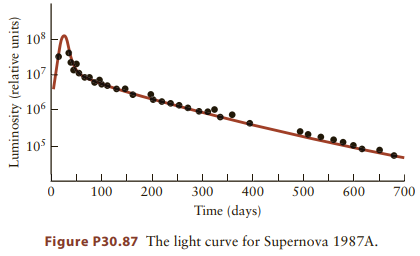At a relatively close 51.4 kiloparsecs away from the Earth, the supernova of 1987 was the closest
Question:
At a relatively close 51.4 kiloparsecs away from the Earth, the supernova of 1987 was the closest nova to occur since telescopes were invented, and it allowed a unique opportunity to confirm that radioactive decay rates are constant over time. Theoretical considerations of the fusion processes in the extreme environment of a supernova blast predict that many isotopes will be created, including a large amount of the short-lived isotope 56Co with a half-life of 77.1 days. Figure P30.87 shows the intensity of the light measured from SN1987A as a function of time. A few weeks after the peak intensity, the light from the explosion decays exponentially as a function of time, as one would expect if the light were being generated due to radioactive decay of the created 56Co.
(a) How long ago did the explosion of the supernova take place?
(b) Using the light curve in Figure P30.87, estimate the half-life of this 56Co and compare it with the known half-life.
(c) Does the result in part (b) suggest that the decay rate of 56Co is the same now as it was at the time of the explosion of SN1987A, or does it provide evidence that the decay rate has changed over time?

Step by Step Answer:

College Physics Reasoning and Relationships
ISBN: 978-0840058195
2nd edition
Authors: Nicholas Giordano





